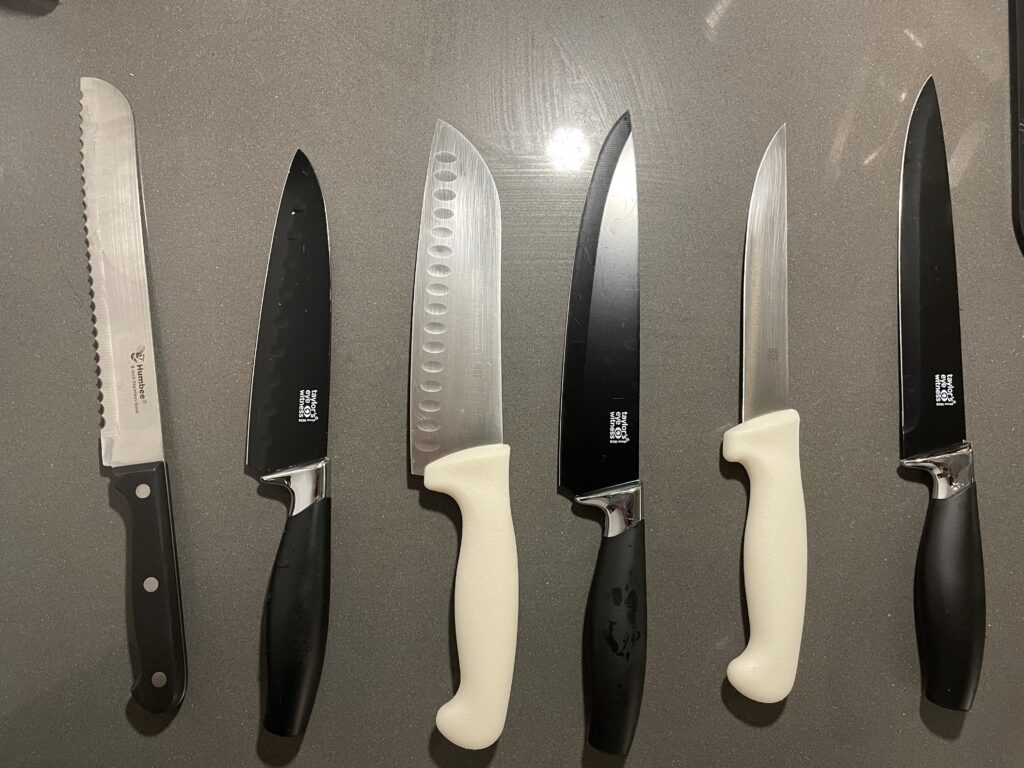Identifying my Knives
I was cooking a meal with a friend a few weeks ago, and we were talking knife safety. Along the way, I realized that I don’t really know knifes very well! For example, I am not sure what they’re called, what cutting task each one is best suited for, etc. So, here’s a brief show-and-tell of my six (cheap) knives…

Bread Knife
This I bought intentionally to cut bagels from Trader Joe’s, so I am fairly familiar with the purpose of this one. According to the article…
Bread knives are used for cutting bread, cakes, and sometimes meat, poultry, and seafood. They are designed in a way that allows you to saw through the bread without pushing down or squishing it.
HealthyKitchen101.com
Chef’s Knife
Even though this is a general-purpose knife, I honestly find myself using this one the least. I read the following, which might explain why:
A chef’s knife can be forged or stamped, although the best kitchen knives are usually forged. Because it has to endure frequent use, it usually comes with a full tang— the bottom part of its blade extends to the whole length and width of the knife handle. This ensures better stability and durability than a partial tang.
HealthyKitchen101.com
This knife is cheaply made! It feels flimsy in my hand, and just not satisfying to use. Put into more technical terms, it’s because it’s a stamped knife (i.e., made from flexible steel, read more here) that does not come with a full tang. By full tang, I mean the metal does not run through the handle. In other words, there is no metal sandwiched between the handle (see visual).
I will keep using it, though, because it is the only one with a tapered blade that I can rock back and force to mince food (e.g., garlic). At least, until I replace it with a forged chef’s knife…
Santoku Knife
I really only use the white Tramontina knife; the black one is much more unsatisfying to use, and I like the shape a tad bit less. Overall, though, this is my favorite style of knife. It, like the chef’s knife, is also general-purpose:
The Santoku knife is a Japanese version of the Western-style chef’s knife. It’s slightly shorter and thinner, and is used in place of the chef’s knife by some cooks, especially those who prefer a smaller, lighter blade. Santoku means “three virtues”, which are slicing, dicing, and mincing. This knife is an all-rounder and can do almost everything a typical chef’s knife can.
HealthyKitchen101.com
I particularly love the way that I can use the pinch grip with this knife (see image); it makes me feel like I actually know what I’m doing in the kitchen… 😅
Boning Knife
I identified this one by finding the exact model in a kitchen store!
Featuring flexible, semi-flexible, or stiff options, boning knives allow users to separate meat from bones while reducing the amount of wasted meat. Boning knives come in a variety of sizes and knife styles…
Webstaurant store
This one is on the stiffer end, so it might be more difficult for me to bone meats (i.e., separate the bone from meat in something like chicken). The stiffness could, however, make it easier for me to joint a chicken (breaking a chicken into its wings, legs, breast, and thigh).
Carving Knife
This was the categorization I was least secure about, but I have managed to convince myself due to the pointy-ness of the tip, its length (it’s the longest knife I have), and its thinness:
With long blades, meat carving knives are the ideal choice for slicing cooked meats like smoked ham, roasted chicken, or deep fried turkey. Carving knives are much thinner than chef knives, enabling them to carve thinner, more precise slices.
Webstaurant store
I never make anything I need to carve, so this one very rarely gets used…
I think that’s it!